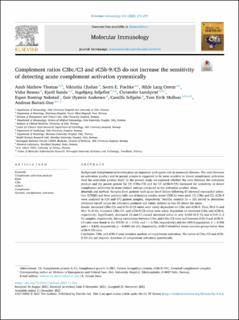| dc.contributor.author | Thomas, Anub Mathew | |
| dc.contributor.author | Chaban, Viktoriia | |
| dc.contributor.author | Pischke, Soeren | |
| dc.contributor.author | Orrem, Hilde Lang | |
| dc.contributor.author | Bosnes, Vidar | |
| dc.contributor.author | Sunde, Kjetil | |
| dc.contributor.author | Seljeflot, Ingebjørg | |
| dc.contributor.author | Lundqvist, Christofer | |
| dc.contributor.author | Nakstad, Espen Rostrup | |
| dc.contributor.author | Andersen, Geir Øystein | |
| dc.contributor.author | Schjalm, Camilla | |
| dc.contributor.author | Mollnes, Tom Eirik | |
| dc.contributor.author | Barratt-Due, Andreas | |
| dc.date.accessioned | 2022-02-04T13:01:26Z | |
| dc.date.available | 2022-02-04T13:01:26Z | |
| dc.date.created | 2022-01-25T15:54:12Z | |
| dc.date.issued | 2021 | |
| dc.identifier.citation | Molecular Immunology. 2021, 141 273-279. | en_US |
| dc.identifier.issn | 0161-5890 | |
| dc.identifier.uri | https://hdl.handle.net/11250/2977206 | |
| dc.description.abstract | Background
Complement activation plays an important pathogenic role in numerous diseases. The ratio between an activation product and its parent protein is suggested to be more sensitive to detect complement activation than the activation product itself. In the present study we explored whether the ratio between the activation product and the parent protein for C3 (C3bc/C3) and for C5 (sC5b-9/C5) increased the sensitivity to detect complement activation in acute clinical settings compared to the activation product alone.
Materials and methods
Samples from patients with acute heart failure following ST-elevated myocardial infarction (STEMI) and from patients with out-of-hospital cardiac arrest (OHCA) were used. C3, C3bc and C5, sC5b-9 were analysed in 629 and 672 patient samples, respectively. Healthy controls (n = 20) served to determine reference cut-off values for activation products and ratios, defined as two SD above the mean.
Results
Increased C3bc/C3- and sC5b-9/C5 ratios were vastly dependent on C3bc and sC5b-9. Thus, 99.5 % and 98.1 % of the increased C3bc/C3- and sC5b-9/C5 ratios were solely dependent on increased C3bc and sC5b-9, respectively. Significantly decreased C3 and C5 caused increased ratios in only 3/600 (0.5 %) and 4/319 (1.3 %) samples, respectively. Strong correlations between C3bc and C3bc/C3-ratio and between sC5b-9 and sC5b-9/C5-ratio were found in the STEMI- (r = 0.926 and r = 0.786, respectively) and the OHCA-population (r = 0.908 and r = 0.843, respectively; p < 0.0001 for all). Importantly, sC5b-9 identified worse outcome groups better than sC5b-9/C5-ratio.
Conclusion
C3bc and sC5b-9 were sensitive markers of complement activation. The ratios of C3bc/C3 and sC5b-9/C5 did not improve detection of complement activation systemically. | en_US |
| dc.language.iso | eng | en_US |
| dc.publisher | Elsevier | en_US |
| dc.rights | Navngivelse 4.0 Internasjonal | * |
| dc.rights.uri | http://creativecommons.org/licenses/by/4.0/deed.no | * |
| dc.title | Complement ratios C3bc/C3 and sC5b-9/C5 do not increase the sensitivity of detecting acute complement activation systemically | en_US |
| dc.type | Peer reviewed | en_US |
| dc.type | Journal article | en_US |
| dc.description.version | publishedVersion | en_US |
| dc.source.pagenumber | 273-279 | en_US |
| dc.source.volume | 141 | en_US |
| dc.source.journal | Molecular Immunology | en_US |
| dc.identifier.doi | 10.1016/j.molimm.2021.11.016 | |
| dc.identifier.cristin | 1989748 | |
| dc.relation.project | Norges forskningsråd: 223255 | en_US |
| cristin.ispublished | true | |
| cristin.fulltext | original | |
| cristin.qualitycode | 1 | |

